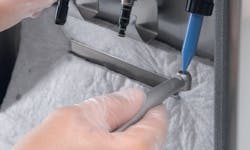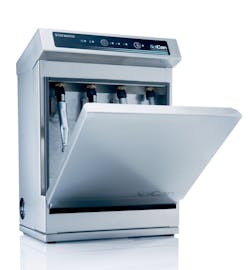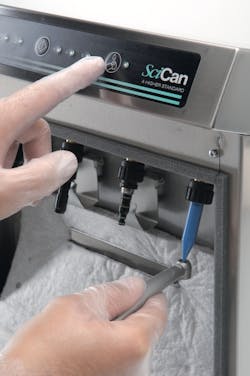Electric handpieces: Should you invest in an automatic handpiece maintenance machine?
Editor's note: This article is the third in a series about dental handpieces. Part 1 of the series, published in August 2019, focused on what to consider when purchasing a handpiece, including how to spot counterfeit handpieces and handpieces that haven't been FDA-approved. Part 2, published in September 2019, focused on how to manually maintain your handpieces.
A casual glance through any dental supply catalog will show around eight different types of automatic handpiece maintenance machines sold by the major handpiece brands. The manufacturers tout consistency and reliability with the use of their maintenance units, and one company is willing to extend its handpiece purchase warranty if its maintenance machine is purchased along with new handpieces.
Handpiece flush stations
A second category of maintenance devices that goes along with handpieces is the handpiece flush station. This is just a simple air-powered countertop unit that augments the normal maintenance procedures that are taking place in the sterilization area. Handpiece maintenance protocol indicates running the handpiece briefly after lubrication to expel excess oil. If the handpiece has been removed from the operatory to facilitate room setup for the next patient, then the staff member would have to spray oil into the handpiece, and then return to one of the operatories to attach the handpiece to the tubing in order to pressurize the handpiece to run the turbine. Return trips to an operatory every time you process a handpiece is inefficient, so a flush station in the sterilization area allows the handpiece to simply be pressed down on a trigger device to run air through the handpiece after lubricating it.
Flush stations are inexpensive, in the $250 to $450 range, but do require a compressed air line in proximity to where they will be used. A flush station does not take up much counter space, but there is a concern over the expelled oil creating a mess in the area. There are spray guards available that snap over the handpiece head to capture the expelled oil. If the team is using a spray or dropper oil system to maintain the handpieces away from the operatories, a flush station is a simple way to really speed up the process.
A handpiece maintenance machine can be a significant investment for the practice, with costs ranging from $1,800 to $3,000. These units are sizable, with footprints varying around a foot wide and a foot deep, so they can take up some valuable countertop real estate. All of the maintenance machines require a compressed air line to operate, and a few models call for an electrical outlet to operate electronic controls and alarms or a small electric motor for attachments.
Typically, a handpiece maintenance unit can handle up to four handpieces per cycle, but be aware that some units can only process one handpiece at a time. Most of the machines offer a separate chuck cleaning port to shoot pressurized cleaner/lubricant into the chuck. This is a great feature and is highly recommended to extend the life of your push-button chucks and enhance their performance.
To qualify as an “automatic” maintenance machine, a staff member has to be able to load the unit and only press one button to activate the machine. Once the cycle begins, the staff member can turn to other responsibilities. The whole purpose of these machines is to alleviate staff time and involvement so they can perform other duties while the handpieces are being processed.
A second major selling point is the consistent application of a measured amount of lubricant to each handpiece every time. The majority of manufacturers offer a combined cleaner/lubricant aerosol can that installs into the machine. A few companies feature the ability to use two separate cans of cleaner and lubricant if that is preferred. One thing to be aware of when purchasing a maintenance machine is whether or not the machine will accept any brand of spray oil, or if you are locked into using only that company's proprietary can. Purchasing a unit with a universal can adapter allows you to choose what type of cleaner/lubricant you wish to use.
The aerosol cans for these units can cost anywhere from $50 to $90, so you may not want to be locked into a specific brand of oil. Some machines work with a liquid oil in a tank instead of a spray can. Be sure you know how much the oil will cost, as prices can range from $112 to $230 per liter of oil. Because the expelled lubricant has to go somewhere at the end of the cycle, most of the machines have absorbent pads inside to collect the spent oil without creating a mess.
Handpiece compatibility is not a problem across all brands. Each manufacturer sells adapters to go with their machines that will accommodate any model of handpiece you may have. These adapters sell anywhere from $100 to $250, depending on the complexity of the design. Most handpieces that are being processed will have a quick disconnect to make attachment and removal quick and easy. The typical process will begin with a spray of oil, and then the handpiece is operated and purged with compressed air. Some units come preprogrammed from the factory, while others have a feature that allows the operator to set different cycle times for different handpieces. All of the machines will operate high-speed handpieces, low-speed attachments, and electric attachments. There are a couple machines on the market that have an electric motor to actually turn electric and low-speed attachments, as opposed to just blowing air through them. This is a great feature, but the addition of electrical connections to these units can be problematic.
The takeaway
An automatic handpiece maintenance machine can be a great addition to your practice, helping to simplify your handpiece maintenance protocol, and may increase the life of your handpieces. Because they are expensive and take up valuable space, be sure you know what you are getting before you purchase. If you are not experiencing a lot of handpiece issues, then your current maintenance procedures are working and you may not need to make this investment.
Editor's note: This article first appeared in the Product Navigator. Click here to subscribe. Click here to learn how to submit an article.
About the Author

Glenn Williams
Glenn Williams is the owner of Handpiece Express, an independent handpiece repair company in Round Rock, Texas, that has been in business for 25 years. Prior to that, he was a sales rep for Star Dental handpieces. He has been a speaker for the California Dental Association for several years. He currently serves as the president of the National Dental Handpiece Repair Association.



